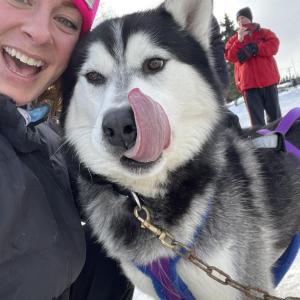A 4-legged start in the last frontier
Imagine the sound of 600 huskies howling and barking in your downtown. The chaos of almost 40 dogsled teams lining up on snowy streets to begin a more than weeklong race running north towards the sea. That’s how Boothbay Harbor resident Emma Gay described her experience volunteering at the 2024 Iditarod in Alaska.
The Iditarod runs from Anchorage to Nome, almost 1,000 miles to the north. The race started March 3, but “start” is a little misleading because the race has two. The official race begins over 70 miles north in Willow, and there is a ceremonial start in Anchorage where teams race down the street to cheering crowds. “It's a giant block party,” Gay said.
Gay volunteered to handle dogs at both starts and, overall, worked with about six teams of about 14 dogs. Gay’s job was to help control the dogs. She had to hold on to one or two excited animals and run alongside them in the slippery snow as they approached the starting line.
“Basically, all of these dogs really want to run. They do not like to stop running,” she said. “I was physically holding onto the dog's lines, and then we would inch up. And then it was time to stop. I was pulling them back ... the dog is standing next to you springing up and down, jumping back and forth over their lines trying to chew their own (line) off because they're just so amped and they need something to do.”
Gay said she wanted to participate because she had never been to Alaska. She has a friend who volunteers at the race and encouraged her to join. Besides, she loves dogs and said she has seen the movie “Balto” on repeat since she was about 4. She has experience with working dogs, but the sled dogs were different. “All of these dogs, they're very friendly. They're lovely dogs,” she said. “But also, on race day, they don't want to talk to you. They're springing up and down. They're ready to go. It's like trying to have a lovely chat with LeBron James on game day. He doesn't want to chat to you, you know?”
The athleticism of both the dogs and mushers impressed Gay, who used to be an athletic trainer in sports medicine. She said the Iditarod is a far cry from Division One athletics. Mushing is a family business for many; and many competitors were children when they started raising dogs.
“I think it’s really inspiring to see a group of people that are competing in this extremely high-level capacity in a completely different culture than where I'm used to seeing high-level competition,” Gay said. “People who have outdoor survival skills that I could not even imagine possessing because I have not been doing this since I was 5.”
Gay said Iditarod organizers monitor the health of the dogs and mushers carefully at medical checkpoints. However, three dogs died on the trail this year, according to the Associated Press; They were the first deaths during the race in five years. Gay said mushers were deeply saddened because they often raise the dogs since they were puppies. However, animal rights activists call for the termination of the race.
Mushers and dogs push themselves to the limits over the grueling course, resting at backcountry camps in the Alaskan wilderness. “The Iditarod, it's not just a dog sledding race, it is a wilderness survival race,” she said. Racers have to be prepared for whatever nature throws at them.
This year, Dallas Seavey, who won, got entangled with a moose early in the race, according to Iditarod officials. According to Alaska Public Media, officials said he did it in self-defense and to protect his dogs, one of which was injured. Rules state mushers must field process the body and distribute the meat. If racers encounter a competitor in the process, they have to assist. “Every single competitor that encounters this situation is like, ‘Actually, we don't care about dog racing for several hours. We care about, can we salvage all of this usable moose?’" she said.
For Gay, the experience was less intense. She was able to explore Alaska during the trip, including a wilderness flight and a visit to Denali National Park. One thing that struck her was how manageable it was. She said roads were sometimes clearer than her commute to work in Southport. Now, she is looking forward to putting in her volunteer application for next year’s race and encouraged others to take their own adventures, even if they are a bit scared.
“It was way more handleable than I thought it was going to be; The experience of handling these dogs was even cooler than I thought it was going to be,” she said. “... Your concern about doing something is probably not going to be nearly as bad once you get there as you thought that potentially it was going to be. I'm not saying don't be prepared. I'm just saying you could just do it. You could just go do it and probably it will be fine.”









































